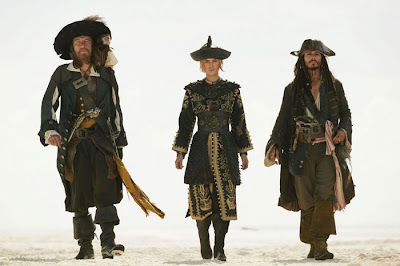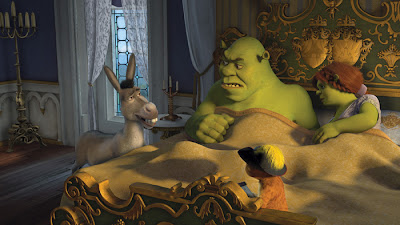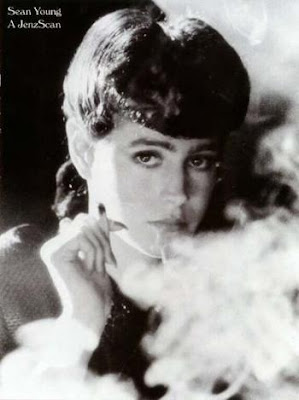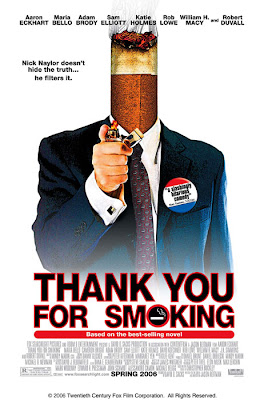
Captain Jack Sparrow: Johnny Depp
Will Turner: Orlando Bloom
Elizabeth Swan: Keira Knightley
Captain Barbossa: Geoffrey Rush
Lord Cutler Beckett: Tom Hollander
Davy Jones: Bill Nighy
“Bootstrap” Bill Turner: Stellan Skarsgard
Tia Dalma: Naomi Harris
Admiral Norrington: Jack Davenport
Captain Sao Feng: Chow Yun-Fat
Walt Disney Pictures presents a film directed by Gore Verbinski. Written by Ted Elliot and Terry Rossio. Based on characters created by Elliot & Rossio and Stuart Beattie and Jay Wolpert and on the Disney amusement park ride. Running time: 168 min. Rated PG-13 (for intense sequences of action/adventure violence and some frightening images).
It seems this might end up being the summer of two and a half star movies. With countless sequels in store over the next couple of months, we’ll continue to see a lot of successful ideas revisited and a bunch of new ideas on dumped on top of their already overstuffed frames. We’ve already seen this with earlier May releases “Spider-Man 3” and “Shrek the Third”. Rounding out this months’ trilogy of trilogies, “Pirates of the Caribbean: At World’s End”, is a film not only overstuffed with ideas, it’s a nearly three-hour extravaganza to boot.
Watching this third installment of pirate adventures based on the popular Disney Parks amusement ride, I was struck with a different approach to critiquing it. Since the filmmakers found it okay to incorporate just about any idea that popped into their heads while crafting its story, I think it would be just as appropriate to drop the standard synopsis/reaction structure of the typical review and discuss all the other ideas that popped into my head while watching it.
Perhaps I shouldn’t have mentioned the three-hour running time, as that never really becomes a factor in the movie. (Although it was a lot of work just to arrange the time to see the film. But that’s the case any time for parents trying to see a movie without the kids.) It will pose the studio a challenge in winning the ever-coveted box office race, since the long running time means there will be fewer opportunities to show the film. But much like the way the filmmakers have overcompensated with the movie’s plot, Disney has certainly more than compensated for the long running time with multiple screenings of the film on the Thursday before it officially opened and by booking it on more screens than any film in history.
To say the screenwriters Ted Elliot and Terry Rossio have gone overboard on plot is really a gross understatement. This film is all plot. Plot, plot, plot, plot, plot! To try to explain everything that happens would be a waste of space and time. (Perhaps that sums up the value of the movie right there.) It involves first saving Captain Jack Sparrow (Johnny Depp, “Finding Neverland”) from the purgatory of Davy Jones’s Locker and then gathering all the pirates in the world (along with the ever-growing list of cast members) to face off against Jones (Bill Nighy, “Love Actually”) and the East India Trading Company (EITC).
Amazingly, the ever-developing plot never bogs down the pace, and three hours slip away fairly unnoticed. There are elements from the previous films, like Jones’s sea-beast the Kraken, that are unfortunately discarded. Even storylines that are introduced in this film, like Tia Dalma and the Calypso, just fizzle away. But the film retains all the high seas adventure, swashbuckling action and state of the art visual effects that made the series popular. And there is still the indomitable performance by Depp to keep it fun.
Unfortunately, the effort needed to focus on so many plots takes away from much of the series’ comedy and charm. Much has been made by critics about the confusing nature of the plot. If you’ve seen the other two, it should be easy enough to keep up, but if you are coming into this a “Pirates” virgin, you will be hopelessly lost. And there are some hallucination scenes involving Depp’s character that will leave even devotees slightly dumbfounded, wondering if they somehow stumbled into “Being John Malkovich” by mistake.
In a review for another film I was reading this past week, the writer quoted a colleague as saying, “There is nothing so tedious as non-stop action.” Whoever said that would have a difficult time with “At World’s End”, but I wouldn’t exactly say the film proves the statement true. The action, though, does lack some of the spectacle of its predecessor, “Pirates of the Caribbean: Dead Man’s Chest”. As I mentioned, there is no threat from some enormous sea-leviathan this time around and the Calypso is not used as effectively as it should be, but there are sword fights in every major location of the film and the sea vessels spend much time ripping each other apart with canon fire.
The movie starts out as any respectable summer popcorn blockbuster should: in an exotic locale (the port city of Singapore), with a spectacular action sequence, and nary an explanation as to just what the hell is going on until after the fact. Gone is the mystery and awe of Davy Jones’s misshapen sea creature crew, so in the scenes involving them, the action takes center stage. And although there is little logic employed in a sequence where Lord Cutler Beckett’s (Tom Hollander, “Pride & Prejudice”) ship is cut to shreds by canon fire, it is one of the most beautiful sequences in visual effects history.
Director Gore Verbinski (“The Ring”), producer Jerry Bruckheimer (“Armageddon”), and the writers also went to a lot of work to present a thinly veiled attack on the Bush administration’s foreign policy and terrorist witch hunt. With their depiction of the EITC’s no tolerance policy against pirates, they spent much more money and took much more time than necessary to get their point across about not assuming that anyone who is different is bad.
Using pirates as their heroes, they have certainly made it clear just how murky the waters can be when trying to determine good and bad. The characters spend almost all of their time double crossing each other to achieve their own ends, and many unlikely alliances are formed. But a scene where all the pirate lords have gathered to decide whether or not to go to war with the EITC succinctly sums up the film’s take on current world politics. Each pirate votes for himself to be the Pirate King, and every potential decision is met with threats and fist fighting. Jack Sparrow offers as an explanation for the pirate lords’ behavior, “This is politics.” A grim, yet accurate reflection.
Will Turner: Orlando Bloom
Elizabeth Swan: Keira Knightley
Captain Barbossa: Geoffrey Rush
Lord Cutler Beckett: Tom Hollander
Davy Jones: Bill Nighy
“Bootstrap” Bill Turner: Stellan Skarsgard
Tia Dalma: Naomi Harris
Admiral Norrington: Jack Davenport
Captain Sao Feng: Chow Yun-Fat
Walt Disney Pictures presents a film directed by Gore Verbinski. Written by Ted Elliot and Terry Rossio. Based on characters created by Elliot & Rossio and Stuart Beattie and Jay Wolpert and on the Disney amusement park ride. Running time: 168 min. Rated PG-13 (for intense sequences of action/adventure violence and some frightening images).
It seems this might end up being the summer of two and a half star movies. With countless sequels in store over the next couple of months, we’ll continue to see a lot of successful ideas revisited and a bunch of new ideas on dumped on top of their already overstuffed frames. We’ve already seen this with earlier May releases “Spider-Man 3” and “Shrek the Third”. Rounding out this months’ trilogy of trilogies, “Pirates of the Caribbean: At World’s End”, is a film not only overstuffed with ideas, it’s a nearly three-hour extravaganza to boot.
Watching this third installment of pirate adventures based on the popular Disney Parks amusement ride, I was struck with a different approach to critiquing it. Since the filmmakers found it okay to incorporate just about any idea that popped into their heads while crafting its story, I think it would be just as appropriate to drop the standard synopsis/reaction structure of the typical review and discuss all the other ideas that popped into my head while watching it.
Perhaps I shouldn’t have mentioned the three-hour running time, as that never really becomes a factor in the movie. (Although it was a lot of work just to arrange the time to see the film. But that’s the case any time for parents trying to see a movie without the kids.) It will pose the studio a challenge in winning the ever-coveted box office race, since the long running time means there will be fewer opportunities to show the film. But much like the way the filmmakers have overcompensated with the movie’s plot, Disney has certainly more than compensated for the long running time with multiple screenings of the film on the Thursday before it officially opened and by booking it on more screens than any film in history.
To say the screenwriters Ted Elliot and Terry Rossio have gone overboard on plot is really a gross understatement. This film is all plot. Plot, plot, plot, plot, plot! To try to explain everything that happens would be a waste of space and time. (Perhaps that sums up the value of the movie right there.) It involves first saving Captain Jack Sparrow (Johnny Depp, “Finding Neverland”) from the purgatory of Davy Jones’s Locker and then gathering all the pirates in the world (along with the ever-growing list of cast members) to face off against Jones (Bill Nighy, “Love Actually”) and the East India Trading Company (EITC).
Amazingly, the ever-developing plot never bogs down the pace, and three hours slip away fairly unnoticed. There are elements from the previous films, like Jones’s sea-beast the Kraken, that are unfortunately discarded. Even storylines that are introduced in this film, like Tia Dalma and the Calypso, just fizzle away. But the film retains all the high seas adventure, swashbuckling action and state of the art visual effects that made the series popular. And there is still the indomitable performance by Depp to keep it fun.
Unfortunately, the effort needed to focus on so many plots takes away from much of the series’ comedy and charm. Much has been made by critics about the confusing nature of the plot. If you’ve seen the other two, it should be easy enough to keep up, but if you are coming into this a “Pirates” virgin, you will be hopelessly lost. And there are some hallucination scenes involving Depp’s character that will leave even devotees slightly dumbfounded, wondering if they somehow stumbled into “Being John Malkovich” by mistake.
In a review for another film I was reading this past week, the writer quoted a colleague as saying, “There is nothing so tedious as non-stop action.” Whoever said that would have a difficult time with “At World’s End”, but I wouldn’t exactly say the film proves the statement true. The action, though, does lack some of the spectacle of its predecessor, “Pirates of the Caribbean: Dead Man’s Chest”. As I mentioned, there is no threat from some enormous sea-leviathan this time around and the Calypso is not used as effectively as it should be, but there are sword fights in every major location of the film and the sea vessels spend much time ripping each other apart with canon fire.
The movie starts out as any respectable summer popcorn blockbuster should: in an exotic locale (the port city of Singapore), with a spectacular action sequence, and nary an explanation as to just what the hell is going on until after the fact. Gone is the mystery and awe of Davy Jones’s misshapen sea creature crew, so in the scenes involving them, the action takes center stage. And although there is little logic employed in a sequence where Lord Cutler Beckett’s (Tom Hollander, “Pride & Prejudice”) ship is cut to shreds by canon fire, it is one of the most beautiful sequences in visual effects history.
Director Gore Verbinski (“The Ring”), producer Jerry Bruckheimer (“Armageddon”), and the writers also went to a lot of work to present a thinly veiled attack on the Bush administration’s foreign policy and terrorist witch hunt. With their depiction of the EITC’s no tolerance policy against pirates, they spent much more money and took much more time than necessary to get their point across about not assuming that anyone who is different is bad.
Using pirates as their heroes, they have certainly made it clear just how murky the waters can be when trying to determine good and bad. The characters spend almost all of their time double crossing each other to achieve their own ends, and many unlikely alliances are formed. But a scene where all the pirate lords have gathered to decide whether or not to go to war with the EITC succinctly sums up the film’s take on current world politics. Each pirate votes for himself to be the Pirate King, and every potential decision is met with threats and fist fighting. Jack Sparrow offers as an explanation for the pirate lords’ behavior, “This is politics.” A grim, yet accurate reflection.
Buy it: Pirates of the Caribbean DVDs









